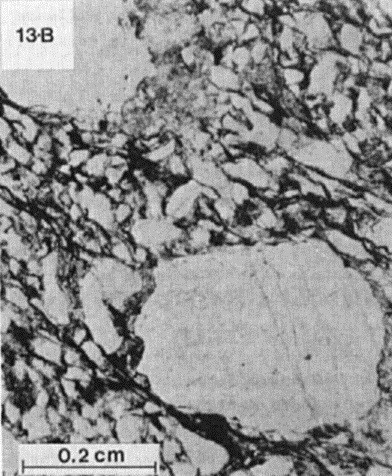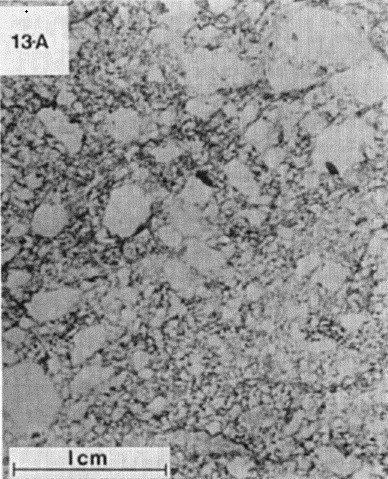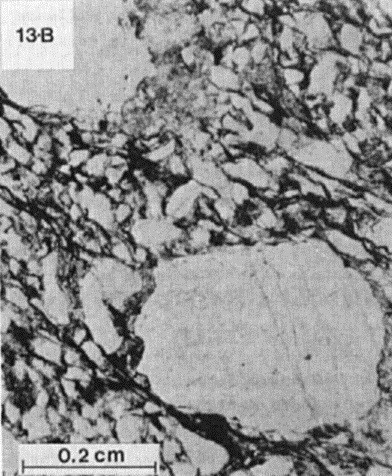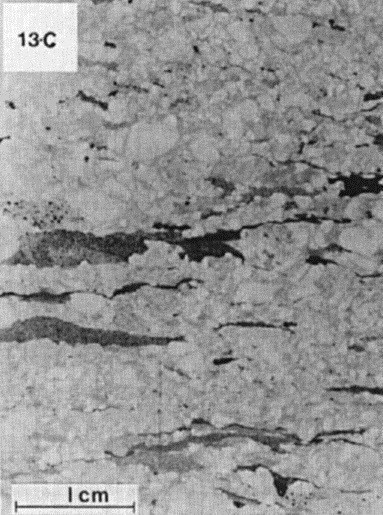
DISCLAIMER: This English version is translated from the original French. In case of any discrepancy, the French version shall prevail.
| Author(s): | Dimroth, 1968 |
| Age: | Paleoproterozoic |
| Stratotype: | The type locality is to the south of the Romanet River (NTS sheet 24B05) |
| Type area: | Romanet Lake area, south of the Romanet River (NTS sheet 24B05) |
| Geological province: | Churchill Province |
| Geological subdivision: | New Quebec Orogen (Labrador Trough) |
| Lithology: | Slate, greywacke, conglomerate, basalt |
| Category: | Lithostratigraphic |
| Rank: | Formation |
| Status: | Formal |
| Use: | Active |
Background
The first descriptions of this unit come from the mapping work of Dimroth (1964). The name Romanet Formation was introduced by Dimroth (1968) to refer to an association of dolomite conglomerate, graphitic greywacke, graphitic greywacke conglomerate and graphitic mudrock south of the Romanet River (sheet 24B05). Rocks of this formation were subsequently mapped by Dimroth (1970, 1972, 1978) and Clark (1986). They were also studied by Kish and Tremblay-Clark (1979) to assess their mineral potential.
Description
The Romanet Formation represents a package of allochthonous volcano-sedimentary rocks. It consists mainly of grey or black graphitic slate, black quartzitic and graphitic grauwacke, dolomite-boulder conglomerate and quartz-cobble conglomerate (Dimroth, 1978; Clark, 1986). The formation also includes metric layers of massive and pillow basalt, locally schistose (Clark, 1986). According to Dimroth (1978), the rocks’ grain size decreases rapidly west of longitude 67°50’W. The Romanet Formation has certain lithological similarities with the Du Chambon Formation, such as the presence of graphitic slate and greywacke (Dimroth, 1978; Clark, 1986). Dimroth (1978) indicated that facies changes within these formations are similar and that there is a correlation between the Romanet and Du Chambon formations. Rocks of the Romanet Formation are interpreted as turbidites (Dimroth, 1978; Clark, 1986).
Romanet Formation 1 (pPro1): Laminated Grey or Black Graphitic Slate; Interbedded Grey or Black Graphitic Greywacke
Unit pPro1 consists of graphitic slate interbedded with 10 cm to several metres-thick greywacke (Dimroth, 1978; Clark, 1986). Slate is dark grey to black, finely bedded (laminated) on a millimetre to centimetre scale and very enriched in graphite. It commonly has two cleavages, more rarely three (Dimroth, 1978). Quartzitic greywacke is dark grey or black, medium to coarse grained and composed of rounded grains of grey to blue quartz 1 to 2 mm in diameter in a graphite-rich matrix. In places, greywacke contains disseminated pyrite cubes up to 2 cm (Kish and Tremblay-Clark, 1979; Clark, 1986).
Romanet Formation 2 (pPro2): Grey or Black Quartzitic Greywacke; Interbedded Granule Sandstone, Graphitic Slate and Graphitic Conglomerate
Unit pPro2 consists of black graphitic quartzitic greywacke (« quartzitic wacke » according to Dimroth, 1978) and interbedded granule sandstone, graphitic conglomerate and graphitic slate. Graphitic conglomerate consists of very poorly sorted clastic elements that are supported by a characteristic matrix. It is formed of coarse quartz cobbles (1 cm in diameter) as well as siltstone and shale fragments in a fine-grained graphitic matrix, which is composed of quartz and 10 to 15% chlorite and sericite. Graphitic slate beds are finely bedded (laminated) and millimetre to centimetre thick. Slate usually has two cleavages, locally three (Dimroth, 1978).
Romanet Formation 3 (pPro3): Dolomite-Boulder Conglomerate
Dolomitic conglomerate is formed of dolomite and dolomitic sandstone boulders, up to 1 m in diameter, in a fine to medium-grained sandstone matrix. Siltstone and mudrock fragments as well as quartz grains (up to 1 cm in diameter) are commonly observed. The matrix is recrystallized and contains blue quartz and interstitial chlorite as the main minerals (Dimroth, 1978; Kish and Tremblay-Clark, 1979).
Romanet Formation 4 (pPro4): Quartz-Cobble Conglomerate
Quartz-cobble conglomerate forms layers up to 3 m thick locally, some of which have been mapped interbedded with graphitic slate of unit pPro1. Conglomerate contains subangular to subrounded quartz cobbles ~1 cm in diameter. Rare fragments of black mudrock are also observed (Clark, 1986).
Romanet Formation 5 (pPro5): Massive and Pillow Basalt, Locally Schistose
The volcanic unit of the Romanet Formation consists of basalt, which forms layers up to several metres thick (Clark, 1986). Basalt is massive and pillowed; locally it is associated with medium-grained gabbro. Massive basalt was observed at one location. It is grey and contains traces of disseminated chalcopyrite. A single layer of schistose basalt, ~18 m thick, was observed. It contains elongated pillows (3 m by 0.6 m) and is in contact with pebble greywacke and slate.
Thickness and distribution
The Romanet Formation belongs to the Wheeler Lithotectonic Zone, as defined by Clark and Wares (2004). It has only been observed south of the Romanet River between longitudes 67°48′W and 68°W (sheet 24B05) (Dimroth, 1978; Clark, 1986), a distance of ~14 km.
Dating
None.
Stratigraphic Relationship(s)
Deposition of Romanet Formation rocks occurred between 2169 ±4 and 2142 +4/-2 Ma, i.e. during the depositional period of first-cycle sedimentary rocks (T. Krogh and B. Dressler, unpublished data cited by Clark, 1984, page 4; Rohon et al., 1993; Clark and Wares, 2004). Dimroth (1978) proposed that the Du Chambon and Romanet formations are correlated, and that the former changes laterally to the latter. According to him and Clark (1986), the Romanet Formation would represent the marginal equivalent of the Du Chambon Formation. The source of the detrital material of both formations was probably located further east, with a westward direction of transport. The source of the detrital material is sedimentary in nature and the production of the detrital fraction would have been generated by uplift of source areas (Clark and Wares, 2004).
The Du Chambon Formation is stratigraphically overlying the Uvé Formation (Pistolet Group) according to Dimroth (1978), which means that the Romanet Formation is younger than the Uvé Formation. The upper stratigraphic contact of the Romanet Formation is not exposed. It should be noted that Dimroth (1978) mentioned that rocks of the Romanet Formation are similar to those of the Lace Lake Formation (Pistolet Group) and that west of longitude 67°53’W, the scarcity of outcrops makes it impossible to distinguish between these two formations. South of the Romanet River, rocks of the Romanet Formation are structurally overlain by rocks of the Dunphy (Seward Group) and Lace Lake formations due to the presence of a major thrust fault (Dimroth, 1978; Clark, 1986). Finally, a cluster of albite breccias (Mistamisk Volcanic Complex) is hosted by the Romanet Formation (Clark, 1986).
Paleontology
Does not apply.
References
Publications Available Through SIGÉOM Examine
CLARK, T. 1984. GÉOLOGIE DE LA RÉGION DU LAC CAMBRIEN – TERRITOIRE DU NOUVEAU-QUÉBEC; MINISTÈRE DE L’ÉNERGIE ET DES RESSOURCES; QUÉBEC; ET 83-02, 77 pages and 1 plan.
CLARK, T. 1986. GÉOLOGIE ET MINÉRALISATIONS DE LA RÉGION DU LAC MISTAMISK ET DE LA RIVIÈRE ROMANET; MINISTÈRE DE L’ÉNERGIE ET DES RESSOURCES; QUÉBEC; ET 83-22, 56 pages and 1 plan.
CLARK, T., WARES, R. 2004. SYNTHÈSE LITHOTECTONIQUE ET MÉTALLOGÉNIQUE DE L’OROGÈNE DU NOUVEAU-QUÉBEC (FOSSE DU LABRADOR); MINISTÈRE DE L’ÉNERGIE ET DES RESSOURCES; QUÉBEC; MM 2004-01, 182 pages and 1 plan.
DIMROTH, E. 1964. GÉOLOGIE DE LA RÉGION DU LAC ROMANET, NOUVEAU QUÉBEC; MINISTÈRE DES RICHESSES NATURELLES, QUÉBEC; RP 523, 20 pages and 1 plan.
DIMROTH, E. 1984. CARTES GÉOLOGIQUES DU LAC ROMANET ET DU LAC CRAMOLET (FOSSE DU LABRADOR). MINISTÈRE DES RICHESSES NATURELLES, QUÉBEC; DP 068, 3 plans.
DIMROTH, E. 1972. STRATIGRAPHY OF PART OF THE CENTRAL LABRADOR TROUGH. MINISTÈRE DE L’ÉNERGIE ET DES RESSOURCES, QUÉBEC; DP 154, 304 pages and 6 plans.
DIMROTH, E. 1978. RÉGION DE LA FOSSE DU LABRADOR ENTRE LES LATITUDES 54°30′ ET 56°30′. MINISTÈRE DE RICHESSES NATURELLES, QUÉBEC; RG 193, 417 pages and 16 plans.
KISH, L., TREMBLAY-CLARK, P. 1979. GÉOCHIMIE ET RADIOACTIVITÉ DANS LA FOSSE DU LABRADOR, 56°00′ – 58°30′. MINISTÈRE DES RICHESSES NATURELLES, QUÉBEC; DPV 666, 33 pages.
Other Publications
DIMROTH, E. 1968. The evolution of the central segment of the Labrador geosyncline; part I: stratigraphy, facies and paleogeography; Neues Jahrbuch fuer Geologie und Paläontologie, Abhandlungen, Stuttgart; volume 132, pages 22-54.
ROHON, M.-L., VIALETTE, Y., CLARK, T., ROGER, G., OHNENSTETTER, D., VIDAL, P. 1993. Aphebian mafic-ultramafic magmatism in the Labrador Trough (New Quebec): its age and the nature of its mantle source. Canadian Journal of Earth Sciences; volume 30, pages 1582-1593. http://doi.org/10.1139/e93-136
Suggested Citation
Ministère de l’Énergie et des Ressources naturelles (MERN). Romanet Formation. Quebec Stratigraphic Lexicon. https://gq.mines.gouv.qc.ca/lexique-stratigraphique/province-de-churchill/formation-de-romanet_en [accessed on Day Month Year].
Contributors
|
First publication |
Charles St-Hilaire, GIT, M.Sc. charles.st-hilaire@mern.gouv.qc.ca (redaction) Mehdi A. Guemache, P. Geo., Ph.D. (redaction and coordination); Thomas Clark, P. Geo., Ph.D. (critical review); Simon Auclair, P. Geo., M.Sc. (editing); Céline Dupuis, P. Geo., Ph.D. (English version); Ricardo Escobar Moran (HTML editing). |




